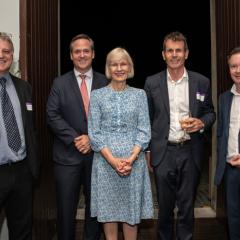Queensland looks well placed to exceed its 50% renewable energy target ahead of schedule – and gas will be a fundamental part of the equation ensuring grid stability into the future, according to one of the state’s leading energy economists.
Powerlink CEO Professor Paul Simshauser AM made the prediction when speaking on ‘All Things Energy’ when hosted by the UQ Liveris Academy and UQ Centre for Natural Gas recently.
Professor Simshauser said the state has long been a leader in the development of solar and wind projects, as Queenslanders plug into rooftop solar PV and industry invests in utility scale wind. Queensland has the highest market share of solar PV in the world (at 42%) and if North Queensland was a country, its total variable renewable market share would rank second only to Denmark.
“We’re seeing things in North Queensland that we haven’t seen anywhere in the world,” he said.
While solar and wind are leading the renewables revolution, generation from both tends to decline in the early evening which is when Queensland uses most of its power – and of course there can be long periods with relatively low generation.
“That’s why pumped hydro can be so helpful to the generation plant mix – along with batteries they are capable of shifting intermittent renewable resources into the high demand / low renewable generation periods. If we do not have enough renewable or hydro on any given day, that’s when you flip on the gas turbines.
“Gas turbines are just a great crash pad and they’ll make sure that the lights stay on. They’re a relatively cheap form of insurance and quick to start and produce when required, so they’re good technology in that regard.”
Professor Simshauser said energy reliability (long term planning) and security (real time response) were vital for keeping the lights on – and that managing environmental and cost constraints were equally important.
Professor Simshauser highlighted a necessary focus on the energy economy as a fundamental concern for all of us, as the system transforms.
Energy costs as a proportion of household incomes disproportionately impacts lower socio-economic families. Even in Queensland, which has an abundance of energy, a proportion of households meet a formal definition of being ‘energy poor’.
“That's why we need to be very thoughtful about energy policy and, in particular, trying to drive costs and prices down. That's always the way to keep households out of what we refer to as fuel poverty,” Professor Simshauser said.
Equally important, he said, was ensuring energy access globally.
“I want to see the world decarbonise faster than anyone but also I know that affordable power is one of those three absolute cornerstones of any developing society.
“If you can get access to electric power, communications and transport, you’ll have a good and prosperous society. It’s a matter of how we power, manage and move all economic activity – and in turn look after people,” Professor Simshauser said.
“Comparatively wealthy countries like Australia can decarbonise faster. We’ve got a job to do to make sure we chart a path forward.”
With Professor Simshauser expecting us to reach our 50% RET by around 2027, it seems Queensland is on the right track.



